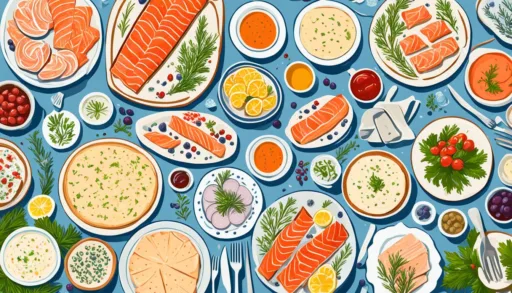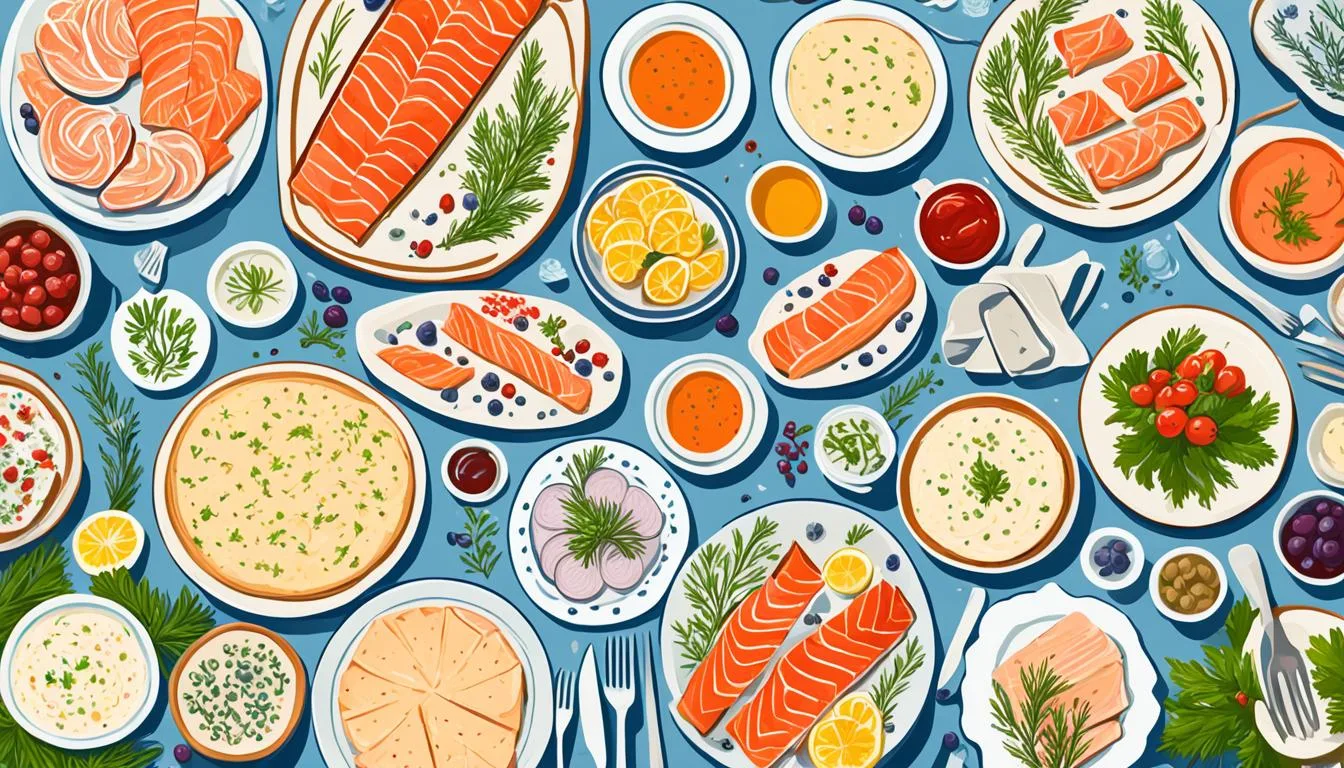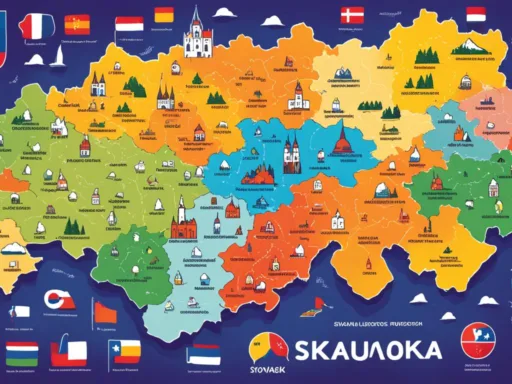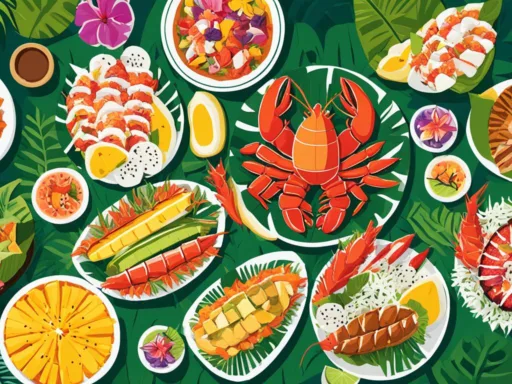Norway, a country renowned for its majestic fjords, also boasts a vibrant culinary landscape that is as diverse as its scenery. Embark on a Norwegian Food Guide that transcends beyond the simplistic fisherman’s fare to a world where traditional Norwegian dishes delight with their complex flavors and rich history. Discover how the staples of Norwegian cuisine weave together the threads of the past with present-day gastronomic practices. Norway’s table is set with more than just food; it’s an invitation to experience the very essence of Nordic food culture. Are you ready to take your taste buds on a Norwegian adventure?
Let us take our first steps on this culinary journey along the pristine Norwegian coastline, exploring the bountiful harvest of the cold, clear waters that shape much of the nation’s traditional fare. Here, the dill-infused Gravlaks cured salmon is not just a dish, but a treasured experience offering the immediate essence of Norway’s natural abundance and deep-rooted cooking traditions. Yet, this journey is not solely about seafood; it encompasses a wide range of flavors including rustic meat dishes, light lunches, vegetarian delights, and sweet confections that are integral to the traditional Norwegian dishes and the enduring Nordic food culture.
Key Takeaways
- Grasp the breadth of Norwegian cuisine starting with its seafood-infused beginnings.
- Uncover the significance of dill and other herbs in flavoring traditional Norwegian dishes.
- Explore the harmony between Norway’s natural resources and its gastronomic heritage.
- Learn how modern chefs are embracing traditional recipes within the Norwegian Food Guide.
- Gain insights into the vegetarian and sweet alternatives enriching the Nordic food culture.
- Anticipate how the famed Norwegian lunch resonates with simplicity and satisfaction.
The Allure of Norwegian Seafood: An Ocean of Flavors
Norwegian seafood encapsulates the essence of authentic Norwegian food, with the icy waters of the North Atlantic providing some of the finest seafood available. Its reputation for quality and freshness not only makes it a staple in the best Norwegian recipes but has also placed Norway firmly on the global culinary map.
Exquisite Norwegian Salmon: A Global Delicacy
Among the popular Norwegian ingredients, Salmon stands out as a cultural icon, renowned worldwide for its superior flavor and texture. The practice of preparing Gravlaks, a method of curing salmon with sugar, salt, and dill, is a beloved tradition that enhances the salmon’s natural richness. This dish, emblematic of Norwegian heritage, remains a celebrated example of Norway’s culinary expertise.
Hearty Fish Soup (Fiskesuppe): A Taste of the Sea
Another cornerstone of the Norwegian seafood tradition is the hearty Fish Soup, locally called Fiskesuppe. This comforting bowl of goodness features a symphony of local catches like pollock, cod, or salmon, bathed in a creamy broth alongside potatoes, carrots, and celery. It’s a symphonic medley that tastefully conveys the subtleties of the ocean’s flavors, solidifying its status as a culinary delight.
A Taste of Tradition: Norway’s Hearty Meals
Experiencing authentic Norwegian food is akin to taking a voyage through time, where each dish carries with it a narrative of Norwegian food traditions and culture. The robust, comforting flavors found in traditional Norwegian dishes are a testament to the country’s rich history and the values they hold dear, particularly when it comes to festive celebrations and the honoring of heritage through cuisine.
Pinnekjøtt: A Seasonal Feast
On a cold winter’s evening, the scent of Pinnekjøtt often fills Norwegian homes, signaling the arrival of Christmas. This beloved dish is an essential part of holiday dining, made from air-dried rib of sheep that has been meticulously rehydrated and steamed over birch branches. With its rich, smoky flavor, Pinnekjøtt is usually served with a side of creamy mashed kohlrabi, creating a harmony of tastes that are deeply embedded in the heart of Norwegian Christmas traditions.
Indulge in Reindeer: Norway’s Gamey Specialty
The consideration for sustainability and traditional practices can be tasted in every bite of a classic Norwegian reindeer dish. Lean yet packed with robust flavors, reindeer meat is often complemented by classic accompaniments such as velvety mashed potatoes and the tartness of lingonberry jam. These combinations not only highlight the versatility of game meats in Norwegian cuisine but also the importance of preserving ancient food practices unique to this remarkable region.
| Dish | Main Ingredient | Typical Sides | Occasion |
|---|---|---|---|
| Pinnekjøtt | Air-dried rib of sheep | Mashed kohlrabi | Christmas |
| Reindeer | Reindeer meat | Mashed potatoes and lingonberry jam | Celebratory feasts |
In exploring these Norwegian gastronomic rituals, one uncovers not just the country’s culinary prowess but a deep-rooted respect for the land, the seasons, and the ancient methods of preparation that still inform the contemporary Norwegian palate.
Norwegian Sweet Indulgences: From Lefse to Svele
In the realm of Norwegian desserts, there is a remarkable array of sweet Norwegian treats that both locals and visitors adore. Among these are traditional favorites like Lefse and Svele, each offering a unique taste of Norway’s dessert culture. But perhaps the crown jewel of the Norwegian dessert menu stems from the highlands and the wild tundra, embodied by the luscious Multebaer cloudberries. These rare berries are celebrated in the form of Multekrem, a luxurious whipped cream dessert that folds in the tantalizingly tart cloudberry fruit, creating a sensation that is both indigenously Norwegian and universally appealing.

Lefse, a type of soft flatbread, is often filled with sweet, delectable ingredients. Here, creativity reigns, with fillings like cinnamon sugar, or even brown cheese for a twist on sweetness, making it a versatile staple in the Norwegian diet. On the other hand, Svele, reminiscent of fluffy pancakes, is typically enjoyed warm, draped in a sheen of melted butter and topped with an assortment of spreads or jams that would tempt any sweet tooth.
- Lefse: The soft flatbread with sweet fillings
- Svele: Warm, pancake-like cakes with buttery toppings
- Multekrem: Whipped cream with tart Multebaer cloudberries
Whether you’re nestled in a cozy Oslo café or adventuring through the picturesque landscapes of the fjords, indulging in these sweet treats enables a delicious deep dive into the sweetness that Norwegian cuisine has to offer. Next time you’re exploring Norway’s culinary delights, remember to leave room for its distinctive and inviting desserts—each with its own rich story and taste.
Norwegian Food Guide: Navigating Through Local Delicacies
Embark on a flavorful quest through the heart of Norwegian cuisine, where each dish speaks volumes of the rich Norwegian gastronomy. Dive into a world where the ocean meets the plate with delicacies like Tørrfisk, an air-dried Atlantic cod with a profound flavor profile, cherished across the coastlines of this Nordic nation. Follow the scent of time-honored traditions to a classic Norwegian lunch, where the combinations of local ingredients and recipes handed down through generations create a harmonious culinary symphony. Here’s your guide to some of the best Norwegian recipes and local specialties to savor:
Experience Norway’s culinary depth one bite at a time, from the jerky-like Tørrfisk to the heartwarming comfort of traditional stews and open-faced sandwiches.
The mastery of Norwegian cooks is evident in their ability to turn simple, homegrown produce into an array of delectable dishes. Below, we present a table that captures the essence of Norway’s culinary delights, offering insights into the ingredients and preparations that make this country’s cuisine so distinctive and beloved.
| Delicacy | Description | Typical Ingredients |
|---|---|---|
| Raspeballer | Potato dumplings commonly enjoyed on Thursdays | Potatoes, flour, salt |
| Komle | A variation of Raspeballer, often served with meat | Potatoes, flour, lamb or pork |
| Rømmegrøt | A traditional sour cream porridge | Sour cream, whole milk, wheat flour, butter, sugar, cinnamon |
| Smalahove | Smoked sheep’s head, a daring yet savory choice | Sheep’s head, salt, pepper |
| Gravlaks | Cured salmon with a gentle hint of dill | Salmon, salt, sugar, dill |
As weave
From Fjords to Farms: Norway’s Bounty
Norway’s scenic landscapes are about much more than just striking beauty; they are the foundation of traditional Norwegian dishes that have been passed down through generations. The journey from the brazen fjords to the lush farms is a testament to the rich and diverse sources of authentic Norwegian food. A feast for the senses and a tribute to Norwegian food traditions, the country’s cuisine is deeply interwoven with its environment.
The icy, clear waters of the fjords are not only a photographer’s muse but also a haven for seafood lovers. Fjord trout and cod are just the beginning of the bounty that these waters yield. Wild salmon from the North Atlantic dive onto the plates of locals and visitors alike, usually graced with the simple yet perfected traditions of Norwegian smoking and curing techniques.
Step away from the waterfront and venture onto the farmlands, where the soil and climate contribute to the unique flavors of Norwegian agricultural produce. Herbs, root vegetables, and berries all form the supporting cast to the main act: organic meats such as lamb in Farikål—a traditional lamb and cabbage stew—and expertly prepared reindeer, served in a variety of delicate dishes that exalt the sophistication of the land.
Norway’s culinary tapestry is as varied as its landscapes, weaving together flavors that range from the salt-kissed oceanic treasures to the hearty and rich meat-centered feasts from the farmlands.
Exploring the hap between wild and cultivated, Norway marries the concept of foraging with agriculture, thus giving a wild twist to even the simplest of dishes. This marriage of sourcing techniques embellishes the palette of Norwegian cuisines, adding layers of complexity and wholesomeness to every bite.
- Fjord Seafood: Freshness with a burst of ocean flavor
- Pastoral Meats: Succulence and depth from the farm
- Berries and Greens: Earthy and vibrant, foraged and farmed
- Herbs and Spices: Aromatic accents enhancing the natural tastes
In embracing these natural influences, Norwegian cooks create dishes that do more than satiate hunger—they tell a story of a land rich with culinary treasure. From fjord to fork, the essential spirit of Norway’s varied geographical bounty is present in every dish, whether sourced from the water’s depths or the soil’s embrace.
Contemporary Twists on Norwegian Classics

As the Norwegian Food Guide delves into the continuous evolution of Nordic food culture, one cannot overlook the contributions made by innovative chefs in the realm of contemporary Norwegian cuisine. In Bergen, a city renowned for its gastronomic flair, Christopher Haatuft at Lysverket is at the forefront of this gastronomic renaissance. Through a fusion of meticulous techniques and a respect for traditional flavors, these chefs are pioneering a thrilling era in Norwegian culinary arts.
At the vanguard of this movement, traditional recipes are being deconstructed and reimagined, creating dishes that intrigue the palate while paying homage to Norway’s rich culinary heritage. Here’s a look at how Lysverket is leading the charge:
- Use of local, sustainably-sourced ingredients to create dishes that tell a story of both place and tradition.
- Application of avant-garde techniques such as sous-vide and foam emulsions to traditional Norwegian food staples.
- Introduction of global flavors and textures which complement classic Norwegian taste profiles.
By respecting the foundational elements that define the classics, yet daring to inject modernity into every dish, Lysverket exemplifies the essence of New Nordic cuisine—with a Norwegian twist. This is more than cooking; it’s a celebration of Norway’s bounty, innovation, and culinary future.
Green and Clean: Norway’s Vegetarian and Vegan Options
The landscape of Norwegian cuisine is witnessing a vibrant transformation towards vegetarian Norwegian dishes and vegan Norwegian food, embodying the progressive spirit of green Norwegian food culture. While Norway’s rich history often highlights a diet heavy in seafood and game, the nation has gracefully embraced the plant-based lifestyle, offering an impressive assortment to cater to the diversifying palate of locals and visitors alike.

Norwegian restaurants now put forth menus that dazzle with meatless innovations, taking culinary arts to new, greener heights. Even in remote areas, where the whisper of Arctic winds speaks of isolation, the availability of vegan-friendly fare showcases Norway’s commitment to culinary inclusivity and sustainability. From Oslo to Tromsø, chefs are championing the plant-based movement with standout dishes that leave a minimal environmental footprint without compromising on taste.
- Fårikål – A traditional dish reinterpreted with a vegetarian twist, using hearty root vegetables and mushrooms in place of lamb.
- Norwegian Flatbreads – Served with a range of plant-based spreads, offering a delicious vegan option for a light snack or part of a larger meal.
- Root Vegetable Stew – A comforting, slow-cooked medley of seasonal vegetables found in Norway’s fertile grounds.
- Seaweed and Tofu Salad – A nod to Norway’s coastal roots, combining the ocean’s bounty with tofu, a staple in vegan cuisine.
Whether one adheres to a vegetarian lifestyle out of concern for animal welfare, personal health, or ecological reasons, Norway provides a delectable haven where green dining does not mean a compromise on tradition or flavor, but a celebration of them. The surge in vegan Norwegian food has contributed to a broader green Norwegian food culture, one that complements the Nordic connection to nature and underscores a sustainable future for all.
The Norwegian Lunch: Simplicity and Satisfaction
Embracing the essence of Nordic food culture, the traditional Norwegian lunch is a daily tribute to the country’s culinary customs. It’s a meal that values simplicity without compromising on satisfaction, highlighting an array of flavors that are central to Norwegian food traditions. A typical lunch spread is a delightful assembly of cold meats, an assortment of cheese, fresh fruits, and hearty bread. These components together paint a picture of Norway’s collective palate.
Seafood, a core element of Norway’s gastronomy, often graces the lunch table. Items like smoked salmon, mackerel, and the iconic herring have a reserved spot in the Norwegian diet, frequently enjoyed alongside whole grain breads and crispbreads. This not only reflects the nation’s love for the ocean’s bounty but also its commitment to a diet that’s both hearty and healthful.
| Traditional Component | Description | Notes |
|---|---|---|
| Cold Meats | Smoked or cured meats such as fenalår and spekeskinke | Often served with flatbread or rugbrød |
| Cheese | Varieties like brunost (brown cheese) and gudbrandsdalsost | Sweet, caramel-like flavor unique to Norway’s culinary heritage |
| Seafood | Marine offerings like gravlaks and sild (herring) | Illustrative of Norway’s strong connection to its fishing traditions |
| Breads | Whole grain breads, knekkebrød (crispbread), and lefse | A staple in every Norwegian home, complementing both sweet and savory toppings |
| Fruits | Apples, berries, plums and other seasonal fruits | Often organic and locally sourced, signifying Norway’s focus on natural produce |
A Norwegian lunch is not just about the food but the experience. It’s a midday pause crafted to replenish both body and spirit, with every bite a testament to the nation’s storied past and its vibrant present. Whether sitting at a café in Oslo or enjoying the quiet of a mountain retreat, a Norwegian lunch is imbued with the purity of the country’s landscapes and the heartiness of its people.
Exploring Regional Variations in Norwegian Cuisine
Delving into the heart of authentic Norwegian food, one cannot help but be enamored by the luscious and distinctive regional Norwegian dishes that narrate a tale of Norway’s extensive food landscape. The sheer variety reflects the depth of Norwegian food traditions and how locals have adapted to the climates and resources available, resulting in a rich tapestry of flavors unique to each fjord and valley.
The west coast city of Bergen is renowned for its fanaost cheese, an aged delight that encapsulates the seasoned craft of Nordic cheesemaking. Moving inland, the rural heartlands serve up rustic fare, such as kjøttkaker, hearty meatballs that are lovingly seasoned and served with a generous helping of mashed peas.
In the far north, where the nights are long and the cold runs deep, the indigenous Sámi people have nourished a tradition of dishes like reindeer blood pancakes, a testament to the region’s resourcefulness and the importance of reindeer in their culture. This is authentic cuisine born from necessity and respect for the land.
- **West Coast** – seafood dominates, featuring dishes such as Rakfisk, fermented fish with a strong flavor profile.
- **Central Norway** – known for Kjøttkaker, robust meatballs that are an everyday comfort food.
- **Northern Regions** – cold climate and Sámi influence bring unique offerings such as the Bidos, a comforting reindeer stew.
Each dish and ingredient furnishes a window into the soul of Norwegian cooking, echoing the spirit of the nation’s ancestors while inviting us to savor the bounties of both sea and land. The regional cuisines of Norway are as varied as they are fascinating, each with a story to savor.
The regional variations extend beyond just the main courses to encompass desserts as well. Northern Norway, with its chilly climate and long winters, offers a variety of unique berry based sweets, while western parts of Norway prefer their desserts rich with dairy produce.
Exploring the regional cuisines of Norway is more than just a feast for the palate—it’s a cultural odyssey that encapsulates the spirit of its people and the essence of its land. As diverse as the landscapes from which they emerge, these regional variations of Norwegian cuisine offer intriguing flavors that are ripe for discovery.
Norway’s Gastronomic Excellence: A Journey of Discovery
Embarking on a journey through Norwegian gastronomy unveils a vibrant pallet of taste and tradition. The intertwined nuances of contemporary Norwegian cuisine and the heartwarming echoes of the best Norwegian recipes offer an adventure for the senses. From the bustling fish markets of Bergen to the award-winning cheeses and spirits, every dish contributes to Norway’s culinary narrative.
Central to this exploration of flavors is the commitment to local ingredients and the simplicity of preparation that comes to life in dishes such as Rakfisk, a fermented trout known for its strong punch, and Kjøttkaker, succulent meatballs in rich, brown gravy. Local eating habits too, lean into the elegance of the ingredients, making every meal an understated celebration of nature’s bounty.
Not only do these culinary experiences delight the tastebuds, but they also tell stories of Norway’s past, present, and vision for the future. It’s a cuisine that respects its heritage while boldly innovating to meet contemporary desires and tastes—illustrating the country’s gastronomic repertoire is as deep and varied as its stunning landscapes.
| Traditional Delights | Contemporary Creations |
|---|---|
| Smalahove (sheep head) | Molecular gastronomy inspired by Nordic ingredients |
| Fanaost (aged cheese) | Bareksten Spirits’ botanical gin |
| Lutefisk (lye fish) | New Nordic cuisine with seasonal foraged elements |
| Rømmegrøt (sour cream porridge) | Fusion dishes combining Norwegian flavors with international techniques |
An exploration of Norwegian gastronomy is to embark on a journey through time and taste, witnessing a culture that both preserves and innovates. It’s where the old is cherished, and the new is welcomed with open arms and a curious palate. In this journey of discovery, the promise of splendor is not just in the eating but also in the rich tales that accompany every bite and sip.
Conclusion: The Culinary Heart of Norway
Our exploration within this Norwegian Food Guide has heralded us through a gastronomic landscape as diverse as the country’s picturesque vistas. From the rich flavors of timeless traditional Norwegian dishes to the bright promise of contemporary plates, we’ve discovered just how deeply rooted the nation’s connection to its food truly is. Norwegian cuisine offers much more than sustenance; it provides a window into the soul of Norway, where each dish narrates a story of its people, land, and heritage.
The journey has been replete with delectable contrasts—from the silken texture of cured salmon to the robust, rustic charm of reindeer meat, all the way to the sweet tartness of cloudberry desserts. It is clear that Norwegian culinary artistry thrives on both honoring its past and innovatively embracing the future. The food does not just satisfy the palate but warms the heart, revealing Norway’s passion for preserving and evolving its culinary traditions.
As we bid farewell to this series, we raise a glass—or rather, a cup of coffee, in true Norwegian fashion—to celebrate the remarkable and inspired fare of Norway. May the flavors we’ve cherished and the knowledge we’ve gained through this guide inspire further exploration and appreciation of Norway’s vibrant culinary scene. Skål to the rich tapestry of tastes that have made this journey both enlightening and truly unforgettable.






